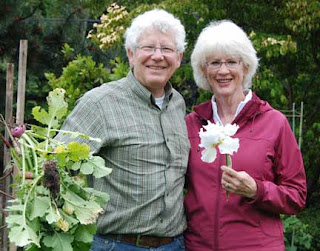Preparations are well underway for the 2010 Highline Garden Tour, which takes place June 12. The annual event, which benefits the Highline Historical Society, has been expanded this year to include five private gardens, as well as the Highline SeaTac Botanical Garden. The tour will also feature two plant sales, coupon specials from business sponsors, screening of a garden documentary, and advice from a Master Gardener. Here's a sneak preview of one of the gardens on the tour...

Peter Barton preparing for the Highline Garden Tour.
After 25 years of carefully tending their half-acre garden just above Maplewild Drive in Burien -- a garden so breathtakingly beautiful that it’s been featured on the cover of Better Homes and Gardens magazine -- Peter and Cathy Barton have every right to sit on their laurels.
Instead, they cut a hole in them -- their laurel hedge, that is -- to frame a new view of Puget Sound. They’ve also been collaborating on some whimsical rebar arbors and sculpture, situated throughout the garden. And this spring they dug up the lawn to make more space for vegetables.
“We’ve doubled our vegetable garden in the last year and a half,” Peter Barton says. “We’re turning this into the sustainability garden.”
A new greenhouse afforded them fresh carrots and cucumbers over the winter, and gave them a jump on their sunflowers this spring. Just across the path, there are a compost tumbler and a worm bin filled with red wigglers enthusiastically producing castings for the garden.
And in a spot where Barton was pushing the lawnmower last summer, this year there are rows of carrots, turnips and strawberries pushing up and ready for harvest.
But Cathy Barton wants to make certain that those who have bought tickets for the 2010 Highline Garden Tour don’t come expecting a mere vegetable patch.
“I’m just afraid that if we say all vegetables, people won’t realize that our garden is designed for all seasons,” she says.

Peter and Cathy Barton in the garden
In addition to the vegetable garden, visitors to this address can expect to enjoy multiple elevation views of the Sound, private sitting spaces, creative paving materials, lots of textures and grasses, shady areas with hostas and astilbes, “-- and the peonies and delphiniums should be in bloom if the sun comes out,” Cathy Barton adds hopefully.
The organically sustained garden is a haven for bees, butterflies, and a variety of songbirds. And later this summer, the Bartons will be welcoming another critter into the garden -- they’re planning to build a chicken coop.
All of the gardens on this year's tour do include vegetables, berry bushes, fruit trees, and other edibles to some degree, but each of the five private gardens also reflects its owner's particular interests -- from an artist's love of color and scene to a retired teacher's memories in the gifts of plants she received from students over the years.
And at the Highline SeaTac Botanical Garden, there will be an exclusive screening of the documentary that tells the remarkable story of the transfer of the historically significant Seike Garden out of the path of SeaTac Airport Expansion to its new home at the Botanical Garden.

The historic Seike Garden
The 2010 Highline Garden Tour is happening June 12. For more information, visit www.highlinehistory.org. Tickets can be purchased in advance at Burien Bark (13258 1st Avenue S, Burien ) and Herr Backyard Garden Center (107 SW 160th, Burien ) or by telephone at 206-241-5786.


